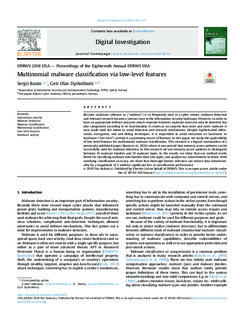| dc.contributor.author | Banin, Sergii | |
| dc.contributor.author | Dyrkolbotn, Geir Olav | |
| dc.date.accessioned | 2018-08-21T10:53:13Z | |
| dc.date.available | 2018-08-21T10:53:13Z | |
| dc.date.created | 2018-08-20T15:18:14Z | |
| dc.date.issued | 2018 | |
| dc.identifier.citation | Digital Investigation. The International Journal of Digital Forensics and Incident Response. 2018, 26 107-117. | nb_NO |
| dc.identifier.issn | 1742-2876 | |
| dc.identifier.uri | http://hdl.handle.net/11250/2558686 | |
| dc.description.abstract | Because malicious software or (”malware”) is so frequently used in a cyber crimes, malware detection and relevant research became a serious issue in the information security landscape. However, in order to have an appropriate defense and post-attack response however, malware must not only be detected, but also categorized according to its functionality. It comes as no surprise that more and more malware is now made with the intent to avoid detection and research mechanisms. Despite sophisticated obfuscation, encryption, and anti-debug techniques, it is impossible to avoid execution on hardware, so hardware (“low-level”) activity is a promising source of features. In this paper, we study the applicability of low-level features for multinomial malware classification. This research is a logical continuation of a previously published paper (Banin et al., 2016) where it was proved that memory access patterns can be successfully used for malware detection. In this research we use memory access patterns to distinguish between 10 malware families and 10 malware types. In the results, we show that our method works better for classifying malware into families than into types, and analyze our achievements in detail. With satisfying classification accuracy, we show that thorough feature selection can reduce data dimensionality by a magnitude of 3 without significant loss in classification performance. | nb_NO |
| dc.language.iso | eng | nb_NO |
| dc.publisher | Elsevier | nb_NO |
| dc.rights | Attribution-NonCommercial-NoDerivatives 4.0 Internasjonal | * |
| dc.rights.uri | http://creativecommons.org/licenses/by-nc-nd/4.0/deed.no | * |
| dc.title | Multinomial malware classification via low-level features | nb_NO |
| dc.type | Journal article | nb_NO |
| dc.type | Peer reviewed | nb_NO |
| dc.description.version | publishedVersion | nb_NO |
| dc.source.pagenumber | 107-117 | nb_NO |
| dc.source.volume | 26 | nb_NO |
| dc.source.journal | Digital Investigation. The International Journal of Digital Forensics and Incident Response | nb_NO |
| dc.identifier.doi | 10.1016/j.diin.2018.04.019 | |
| dc.identifier.cristin | 1603336 | |
| dc.description.localcode | © 2018 The Author(s). Published by Elsevier Ltd on behalf of DFRWS. This is an open access article underthe CC BY-NC-ND license (http://creativecommons.org/licenses/by-nc-nd/4.0/). | nb_NO |
| cristin.unitcode | 194,63,30,0 | |
| cristin.unitname | Institutt for informasjonssikkerhet og kommunikasjonsteknologi | |
| cristin.ispublished | true | |
| cristin.fulltext | preprint | |
| cristin.qualitycode | 1 | |

